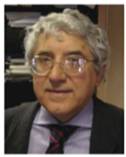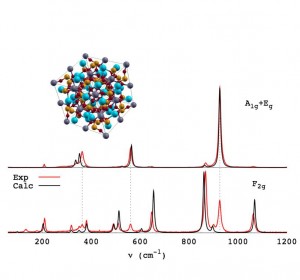 The Italian chemist Roberto Dovesi, full professor at Universita´degli Studi di Torino, where he heads the Theorical Chemistry Group, will be one of the plenary speakers in our XIII SBPMat Meeting. Dovesi will talk about theoretical calculations applied to materials.
The Italian chemist Roberto Dovesi, full professor at Universita´degli Studi di Torino, where he heads the Theorical Chemistry Group, will be one of the plenary speakers in our XIII SBPMat Meeting. Dovesi will talk about theoretical calculations applied to materials.
His scientific activity focuses on the use of a quantum-mechanical approach to solid state chemistry, physics, materials science and surface science. In particular, his primary activityis the implementation of ab initio computer programs for the study of the electronic structure of periodic compounds.
Dovesi is one of the creators of CRYSTAL, a computational tool for the characterization of crystalline solids.The CRYSTAL project started in 1976, and involved (and still involves) a large number of collaborators from many countries. The first version of the software was released in 1988, and then new versions have followed. CRYSTAL is today a licenced program used in more than 350 laboratories in the world. In the last five years, more than 30 PhD students and post-docs from European countries visited the Torino Theoretical Chemistry Group in order to be introduced to the formal aspects and use of the CRYSTAL code.
Every year Dovesi’s group organizes international schools on the quantum-mechanical simulation of solids. One of them was held in 2012 in Brasil. This year four such schools are organized in Perth (Australia), Jahnsi (India), Regensburg (Germany), London (UK) (see at the EVENTS entry in the CRYSTAL web site) .
Roberto Dovesi is the author of more than 250 papers published in international journals and of one book (with Cesare Pisani and Carla Roetti) published by Springer in 1989. Since 1985, he received more than 7.000 citations with h-index=51.
Read our interview with the lecturer.
SBPMat newsletter: – Share with us, very briefly, the story of the developement of CRYSTAL since the first idea up to commercialization.
Roberto Dovesi: – In 1970 Cesare Pisani, Carla Roetti and myself decided to explore the possibilities of simulation as a complement to experiment in the study of crystalline solids.
We started to develop small codes on the basis of the analogy with the codes that were appearing in the litterature as produced mainly by USA universities. In 1976 we started to implement an ab initio quantum mechanical code for solids, using tools and methodologies that were common to the Theoretical Chemistry community (as opposed to the Solid State community). It took 4 years of very hard study and coding to have a first, preliminary result, the band structure of graphite, and its total energy. Eight years later, in 1988, CRYSTAL was ripe enough to be publicly distributed by QCPE (Quantum Chemistry Program Exchange). CRYSTAL has been the first periodic code distributed publicly to the scientific community.
In the meantime many new collaborators where joining the group from many countries (I want to mention at least one of them, Vic Saunders, fron the Daresbury Laboratory, U.K). In the following years many new public releases have been distributed (1992, 95, 98, 2003, 2006, 2009, 2014), each one corresponding to generalizations and extensions of the code in many directions. The last release (CRY14) has been distributed in more than 200 laboratories in less than one year.

SBPMat newsletter: – Please explain to our broad audience what can be done with CRYSTAL in the field of Materials Science and Engineering.
Roberto Dovesi:- CRYSTAL can be used for studying many ground state properties of systems periodic in 1 (nanotubes, polymers), 2 (monolayers, slabs) and 3 (crystals) dimensions; solid solutions, molecules and clusters can be investigated too. Hartree-Fock and DFT of various flavours are the available hamiltonians. A very large set of properties can be studied, the list can be found at www.crystal.unito.it. A short list includes the elastic, piezo-electric, photo-elastic, dielectric, polarizability and hyperpolarizability tensors, the IR and RAMAN spectra, the electron and phonon band structure.
SBPMat newsletter: – Please choose some of your main publications (about 3 or 4) to share them with our public.
Roberto Dovesi: –
1. Raman Spectrum of Pyrope Garnet. A Quantum Mechanical Simulation of Frequencies, Intensities, and Isotope Shifts. Lorenzo Maschio, Bernard Kirtman, Simone Salustro, Claudio M. Zicovich-Wilson, Roberto Orlando and Roberto Dovesi. J. Phys. Chem. A, 2013, 117 (45), pp 11464–11471.
2. Structural, electronic and energetic properties of giant icosahedral fullerenes up to C6000: insights from an ab initiohybrid DFT study. Yves Noel, Marco De La Pierre, Claudio Marcelo Zicovich Wilson, Roberto Orlando, Roberto Dovesi. Phys Chem Chem Phys. 2014, Jun 11; 16(26):13390-401.
3. Symmetry and random sampling of symmetry independent configurations for the simulation of disordered solids. Philippe D’Arco, Sami Mustapha, Matteo Ferrabone, Yves Noël, Marco De La Pierre, Roberto Dovesi. J Phys Condens Matter. 2013 Sep 4; 25(35): 355401.
SBPMat newsletter: – Tell us what do you intend to broach in your plenary talk at SBPMat meeting.
Roberto Dovesi: – I will try to show that nowadays quantum mechanical simulation can be an useful complementary tool to experiment. The decreasing cost of the harware, and the availability of powerful, accurate and general computer codes permits to perform simulations also to non experts. I will show that the number of available properties makes simulation very interesting.
